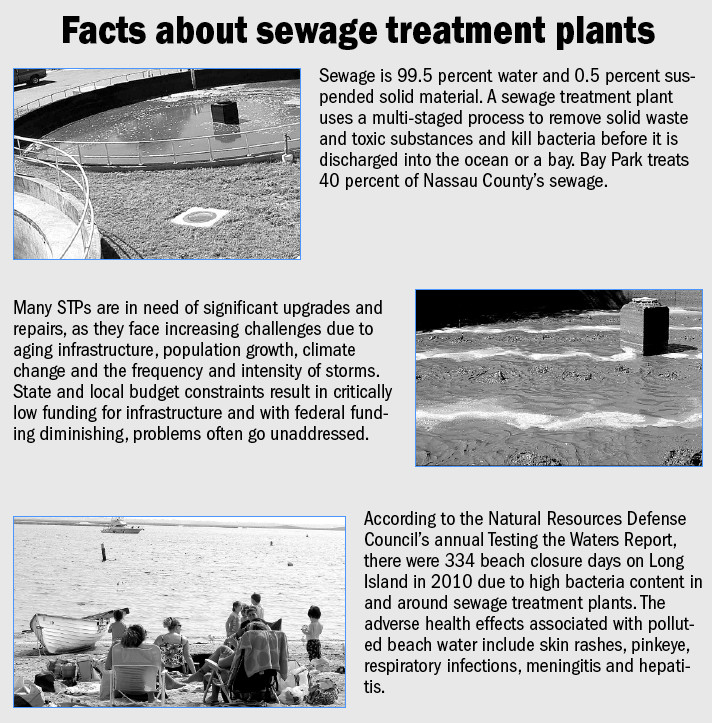Sandy showed Bay Park Sewage Plant shortcomings
Residents, advocacy groups, politicians agree that much more needs to be done; A Q&A with the County DPW
Bay Park resident Nora Garcia-Osuna described what she found in her backyard after Hurricane Sandy as “mounds of hard, layered, crusted-over sewage” — the likes of which she had never seen before.
“We left during the hurricane, and when we came back, this stuff was all over our lawn and backyard,” Garcia-Osuna recounted. “We knew it was from the sewage plant. There was no mistaking it.”
Now, more than three months later, she and some of her neighbors are still waiting for someone to come and clean up their yards. “We’ve been scraping it, raking it, cleaning around where the flowers will come up — if they come up,” she said, explaining that she and her neighbors told county Department of Public Works officials about the dried and encrusted sewage that is still in their neighborhood, But, she added, “The county squashed it. It’s not good.”
The plant goes offline
On Oct. 29, at the height of Hurricane Sandy, a nine-foot tidal surge hit the Bay Park Sewage Treatment Plant, causing catastrophic damage to the plant and its infrastructure. Seawater inundated many parts of the plant, submerging critical pieces of equipment and rendering them inoperable.
Bay Park, sandwiched between three canals and Hewlett Bay, was one of at least six sewage plants on Long Island that went offline during the storm. The plant was shut down for two days, and it was reported that 200 million gallons of partially treated sewage spilled into local waterways. (A state Department of Environmental Conservation spill report, obtained by the Herald, describes the effluent that was released as raw sewage.) The plant was fully operational again on Nov. 21, having treated sewage with chlorine since Nov. 1.
To add insult to serious injury, the county declared a state of emergency two weeks after the hurricane for homes on North Boulevard, in East Rockaway, and Barnes Road, in Baldwin, when there was a breach in a sewer main, causing sewage to bubble up into the surrounding streets and houses.
The failure prompted the county to initiate a three-part mitigation plan that included up to 30 days of temporary “triage” repairs and six to 12 months of permanent repairs to the facility.
Bay Park’s history
The plant, at the southernmost tip of East Rockaway, was built in 1949, when Harry S. Truman was president and the population of Nassau County was about half what it is today. Following a 2011 consolidation with sewer plants in Lawrence and Cedarhurst, Bay Park now treats 65 million gallons of sewage per day — 40 percent of the county’s waste. (The state DEC allows it to process up to 72 million gallons.)
In March 2010, more than 3.5 million gallons of sewage overflowed from the plant into Reynolds Channel, creating a distinct brown plume that was visible to and documented by residents. That October, an investigation by the DEC revealed that the Bay Park facility was only partially treating waste before discharging it, mainly because several critical pieces of equipment were in disrepair or not functioning properly.
Prompted by the condition of the plant, Sen. Charles Schumer asked the U.S. Environmental Protection Agency to reimburse Nassau County $20 million for sewer construction projects that dated back to the mid- 1980s. It wasn’t Schumer’s first request for the money. For over two decades, Nassau County had been seeking reimbursement under an EPA sewer infrastructure grant program for multimillion-dollar upgrades at Bay Park and the Cedar Creek Water Pollution Control Plant. Working with county officials, Schumer persuaded the EPA to release $11 million under the now-defunct program in December 2010.
“Every day the EPA fails to pay the millions it owes Nassau County,” he said, “Reynolds Channel grows more and more toxic, and Nassau taxpayers are more at risk for funding the upgrades needed to fix the problem.”
Last year, the DEC said that enforcement efforts at Bay Park led to numerous improvements in the facility’s system, including the hiring of a new plant operator, the repair of nine final settling tanks, upgrades to pumping equipment, and better inspection and improvement of primary settling tanks.

 48.0°,
Overcast
48.0°,
Overcast 







